Jinyang Liu
Jun
Fast Estimation of Partial Dependence Functions using Trees
Oct 17, 2024
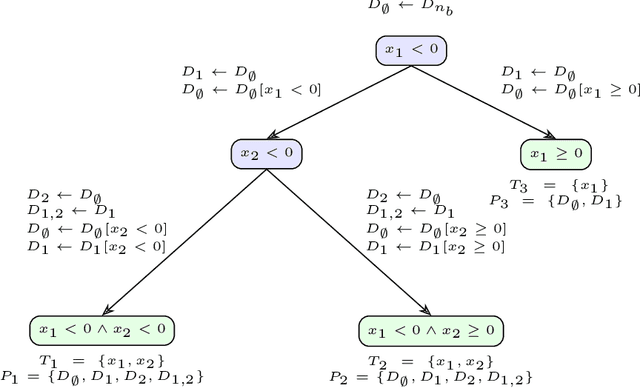
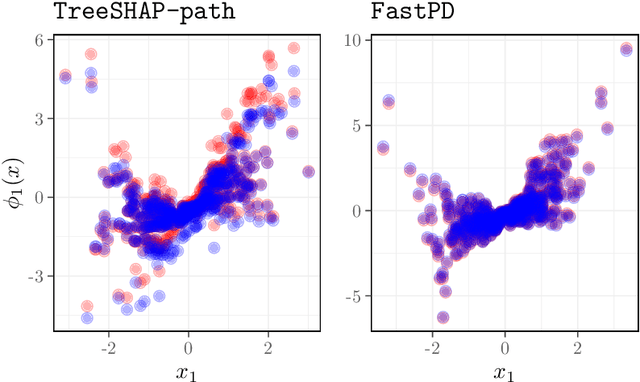
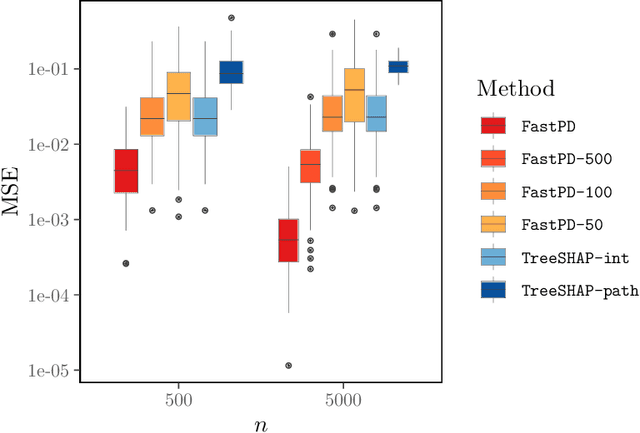
Abstract:Many existing interpretation methods are based on Partial Dependence (PD) functions that, for a pre-trained machine learning model, capture how a subset of the features affects the predictions by averaging over the remaining features. Notable methods include Shapley additive explanations (SHAP) which computes feature contributions based on a game theoretical interpretation and PD plots (i.e., 1-dim PD functions) that capture average marginal main effects. Recent work has connected these approaches using a functional decomposition and argues that SHAP values can be misleading since they merge main and interaction effects into a single local effect. A major advantage of SHAP compared to other PD-based interpretations, however, has been the availability of fast estimation techniques, such as \texttt{TreeSHAP}. In this paper, we propose a new tree-based estimator, \texttt{FastPD}, which efficiently estimates arbitrary PD functions. We show that \texttt{FastPD} consistently estimates the desired population quantity -- in contrast to path-dependent \texttt{TreeSHAP} which is inconsistent when features are correlated. For moderately deep trees, \texttt{FastPD} improves the complexity of existing methods from quadratic to linear in the number of observations. By estimating PD functions for arbitrary feature subsets, \texttt{FastPD} can be used to extract PD-based interpretations such as SHAP, PD plots and higher order interaction effects.
FT K-Means: A High-Performance K-Means on GPU with Fault Tolerance
Aug 02, 2024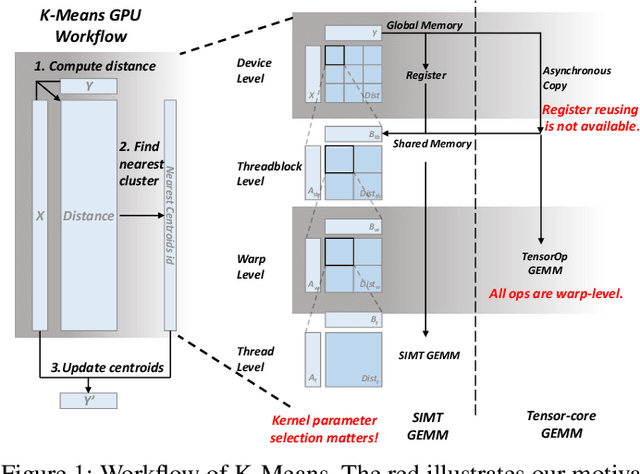
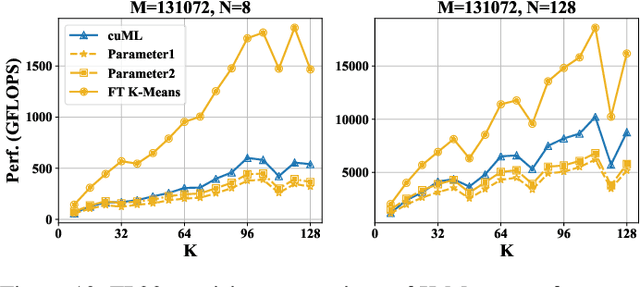
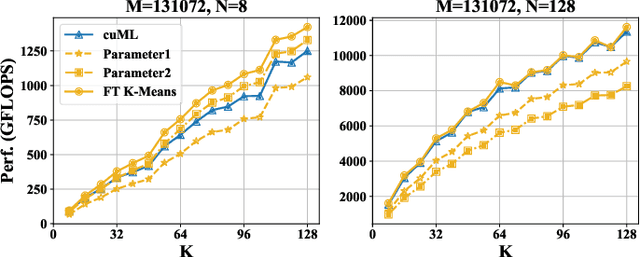
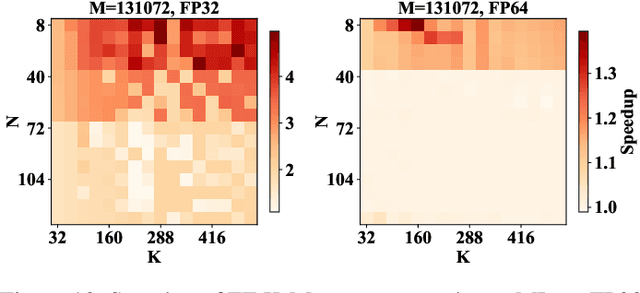
Abstract:K-Means is a widely used algorithm in clustering, however, its efficiency is primarily constrained by the computational cost of distance computing. Existing implementations suffer from suboptimal utilization of computational units and lack resilience against soft errors. To address these challenges, we introduce FT K-Means, a high-performance GPU-accelerated implementation of K-Means with online fault tolerance. We first present a stepwise optimization strategy that achieves competitive performance compared to NVIDIA's cuML library. We further improve FT K-Means with a template-based code generation framework that supports different data types and adapts to different input shapes. A novel warp-level tensor-core error correction scheme is proposed to address the failure of existing fault tolerance methods due to memory asynchronization during copy operations. Our experimental evaluations on NVIDIA T4 GPU and A100 GPU demonstrate that FT K-Means without fault tolerance outperforms cuML's K-Means implementation, showing a performance increase of 10\%-300\% in scenarios involving irregular data shapes. Moreover, the fault tolerance feature of FT K-Means introduces only an overhead of 11\%, maintaining robust performance even with tens of errors injected per second.
3D-HGS: 3D Half-Gaussian Splatting
Jun 04, 2024Abstract:Photo-realistic 3D Reconstruction is a fundamental problem in 3D computer vision. This domain has seen considerable advancements owing to the advent of recent neural rendering techniques. These techniques predominantly aim to focus on learning volumetric representations of 3D scenes and refining these representations via loss functions derived from rendering. Among these, 3D Gaussian Splatting (3D-GS) has emerged as a significant method, surpassing Neural Radiance Fields (NeRFs). 3D-GS uses parameterized 3D Gaussians for modeling both spatial locations and color information, combined with a tile-based fast rendering technique. Despite its superior rendering performance and speed, the use of 3D Gaussian kernels has inherent limitations in accurately representing discontinuous functions, notably at edges and corners for shape discontinuities, and across varying textures for color discontinuities. To address this problem, we propose to employ 3D Half-Gaussian (3D-HGS) kernels, which can be used as a plug-and-play kernel. Our experiments demonstrate their capability to improve the performance of current 3D-GS related methods and achieve state-of-the-art rendering performance on various datasets without compromising rendering speed.
Solving Masked Jigsaw Puzzles with Diffusion Vision Transformers
Apr 10, 2024



Abstract:Solving image and video jigsaw puzzles poses the challenging task of rearranging image fragments or video frames from unordered sequences to restore meaningful images and video sequences. Existing approaches often hinge on discriminative models tasked with predicting either the absolute positions of puzzle elements or the permutation actions applied to the original data. Unfortunately, these methods face limitations in effectively solving puzzles with a large number of elements. In this paper, we propose JPDVT, an innovative approach that harnesses diffusion transformers to address this challenge. Specifically, we generate positional information for image patches or video frames, conditioned on their underlying visual content. This information is then employed to accurately assemble the puzzle pieces in their correct positions, even in scenarios involving missing pieces. Our method achieves state-of-the-art performance on several datasets.
Parameter-Efficient Fine-Tuning for Large Models: A Comprehensive Survey
Mar 21, 2024



Abstract:Large models represent a groundbreaking advancement in multiple application fields, enabling remarkable achievements across various tasks. However, their unprecedented scale comes with significant computational costs. These models, often consisting of billions of parameters, require vast amounts of computational resources for execution. Especially, the expansive scale and computational demands pose considerable challenges when customizing them for particular downstream tasks, particularly over the hardware platforms constrained by computational capabilities. Parameter Efficient Fine-Tuning (PEFT) provides a practical solution by efficiently adapt the large models over the various downstream tasks. In particular, PEFT refers to the process of adjusting the parameters of a pre-trained large models to adapt it to a specific task while minimizing the number of additional parameters introduced or computational resources required. This approach is particularly important when dealing with large language models with high parameter counts, as fine-tuning these models from scratch can be computationally expensive and resource-intensive, posing considerable challenges in the supporting system platform design. In this survey, we present comprehensive studies of various PEFT algorithms, examining their performance and computational overhead. Moreover, we provide an overview of applications developed using different PEFT algorithms and discuss common techniques employed to mitigate computation costs for PEFT. In addition to the algorithmic perspective, we overview various real-world system designs to investigate the implementation costs associated with different PEFT algorithms. This survey serves as an indispensable resource for researchers aiming to understand both the PEFT algorithm and its system implementation, offering detailed insights into recent advancements and practical applications.
Knowledge-aware Alert Aggregation in Large-scale Cloud Systems: a Hybrid Approach
Mar 11, 2024Abstract:Due to the scale and complexity of cloud systems, a system failure would trigger an "alert storm", i.e., massive correlated alerts. Although these alerts can be traced back to a few root causes, the overwhelming number makes it infeasible for manual handling. Alert aggregation is thus critical to help engineers concentrate on the root cause and facilitate failure resolution. Existing methods typically utilize semantic similarity-based methods or statistical methods to aggregate alerts. However, semantic similarity-based methods overlook the causal rationale of alerts, while statistical methods can hardly handle infrequent alerts. To tackle these limitations, we introduce leveraging external knowledge, i.e., Standard Operation Procedure (SOP) of alerts as a supplement. We propose COLA, a novel hybrid approach based on correlation mining and LLM (Large Language Model) reasoning for online alert aggregation. The correlation mining module effectively captures the temporal and spatial relations between alerts, measuring their correlations in an efficient manner. Subsequently, only uncertain pairs with low confidence are forwarded to the LLM reasoning module for detailed analysis. This hybrid design harnesses both statistical evidence for frequent alerts and the reasoning capabilities of computationally intensive LLMs, ensuring the overall efficiency of COLA in handling large volumes of alerts in practical scenarios. We evaluate COLA on three datasets collected from the production environment of a large-scale cloud platform. The experimental results show COLA achieves F1-scores from 0.901 to 0.930, outperforming state-of-the-art methods and achieving comparable efficiency. We also share our experience in deploying COLA in our real-world cloud system, Cloud X.
FaultProfIT: Hierarchical Fault Profiling of Incident Tickets in Large-scale Cloud Systems
Feb 27, 2024Abstract:Postmortem analysis is essential in the management of incidents within cloud systems, which provides valuable insights to improve system's reliability and robustness. At CloudA, fault pattern profiling is performed during the postmortem phase, which involves the classification of incidents' faults into unique categories, referred to as fault pattern. By aggregating and analyzing these fault patterns, engineers can discern common faults, vulnerable components and emerging fault trends. However, this process is currently conducted by manual labeling, which has inherent drawbacks. On the one hand, the sheer volume of incidents means only the most severe ones are analyzed, causing a skewed overview of fault patterns. On the other hand, the complexity of the task demands extensive domain knowledge, which leads to errors and inconsistencies. To address these limitations, we propose an automated approach, named FaultProfIT, for Fault pattern Profiling of Incident Tickets. It leverages hierarchy-guided contrastive learning to train a hierarchy-aware incident encoder and predicts fault patterns with enhanced incident representations. We evaluate FaultProfIT using the production incidents from CloudA. The results demonstrate that FaultProfIT outperforms state-of-the-art methods. Our ablation study and analysis also verify the effectiveness of hierarchy-guided contrastive learning. Additionally, we have deployed FaultProfIT at CloudA for six months. To date, FaultProfIT has analyzed 10,000+ incidents from 30+ cloud services, successfully revealing several fault trends that have informed system improvements.
MTAD: Tools and Benchmarks for Multivariate Time Series Anomaly Detection
Jan 10, 2024Abstract:Key Performance Indicators (KPIs) are essential time-series metrics for ensuring the reliability and stability of many software systems. They faithfully record runtime states to facilitate the understanding of anomalous system behaviors and provide informative clues for engineers to pinpoint the root causes. The unprecedented scale and complexity of modern software systems, however, make the volume of KPIs explode. Consequently, many traditional methods of KPI anomaly detection become impractical, which serves as a catalyst for the fast development of machine learning-based solutions in both academia and industry. However, there is currently a lack of rigorous comparison among these KPI anomaly detection methods, and re-implementation demands a non-trivial effort. Moreover, we observe that different works adopt independent evaluation processes with different metrics. Some of them may not fully reveal the capability of a model and some are creating an illusion of progress. To better understand the characteristics of different KPI anomaly detectors and address the evaluation issue, in this paper, we provide a comprehensive review and evaluation of twelve state-of-the-art methods, and propose a novel metric called salience. Particularly, the selected methods include five traditional machine learning-based methods and seven deep learning-based methods. These methods are evaluated with five multivariate KPI datasets that are publicly available. A unified toolkit with easy-to-use interfaces is also released. We report the benchmark results in terms of accuracy, salience, efficiency, and delay, which are of practical importance for industrial deployment. We believe our work can contribute as a basis for future academic research and industrial application.
SRN-SZ: Deep Leaning-Based Scientific Error-bounded Lossy Compression with Super-resolution Neural Networks
Sep 07, 2023



Abstract:The fast growth of computational power and scales of modern super-computing systems have raised great challenges for the management of exascale scientific data. To maintain the usability of scientific data, error-bound lossy compression is proposed and developed as an essential technique for the size reduction of scientific data with constrained data distortion. Among the diverse datasets generated by various scientific simulations, certain datasets cannot be effectively compressed by existing error-bounded lossy compressors with traditional techniques. The recent success of Artificial Intelligence has inspired several researchers to integrate neural networks into error-bounded lossy compressors. However, those works still suffer from limited compression ratios and/or extremely low efficiencies. To address those issues and improve the compression on the hard-to-compress datasets, in this paper, we propose SRN-SZ, which is a deep learning-based scientific error-bounded lossy compressor leveraging the hierarchical data grid expansion paradigm implemented by super-resolution neural networks. SRN-SZ applies the most advanced super-resolution network HAT for its compression, which is free of time-costing per-data training. In experiments compared with various state-of-the-art compressors, SRN-SZ achieves up to 75% compression ratio improvements under the same error bound and up to 80% compression ratio improvements under the same PSNR than the second-best compressor.
Practical Anomaly Detection over Multivariate Monitoring Metrics for Online Services
Aug 19, 2023



Abstract:As modern software systems continue to grow in terms of complexity and volume, anomaly detection on multivariate monitoring metrics, which profile systems' health status, becomes more and more critical and challenging. In particular, the dependency between different metrics and their historical patterns plays a critical role in pursuing prompt and accurate anomaly detection. Existing approaches fall short of industrial needs for being unable to capture such information efficiently. To fill this significant gap, in this paper, we propose CMAnomaly, an anomaly detection framework on multivariate monitoring metrics based on collaborative machine. The proposed collaborative machine is a mechanism to capture the pairwise interactions along with feature and temporal dimensions with linear time complexity. Cost-effective models can then be employed to leverage both the dependency between monitoring metrics and their historical patterns for anomaly detection. The proposed framework is extensively evaluated with both public data and industrial data collected from a large-scale online service system of Huawei Cloud. The experimental results demonstrate that compared with state-of-the-art baseline models, CMAnomaly achieves an average F1 score of 0.9494, outperforming baselines by 6.77% to 10.68%, and runs 10X to 20X faster. Furthermore, we also share our experience of deploying CMAnomaly in Huawei Cloud.
 Add to Chrome
Add to Chrome Add to Firefox
Add to Firefox Add to Edge
Add to Edge